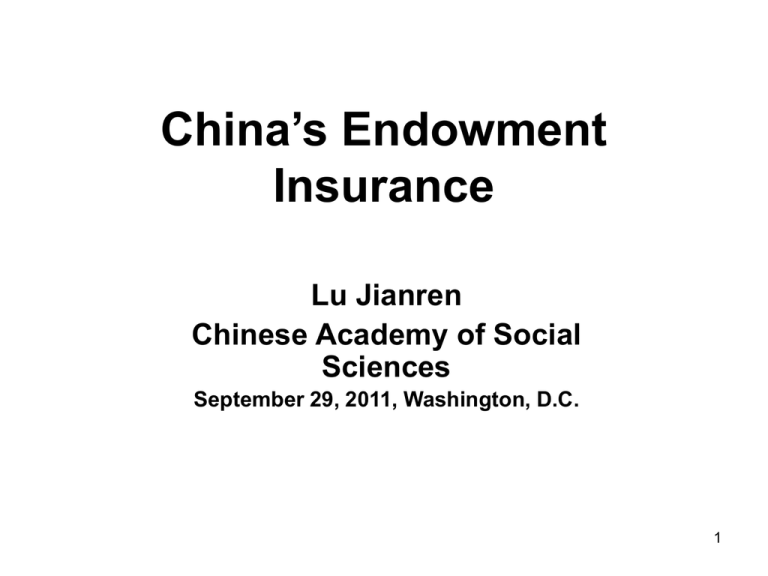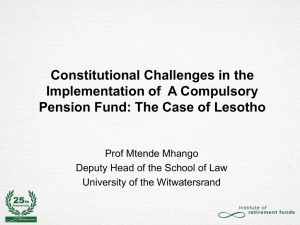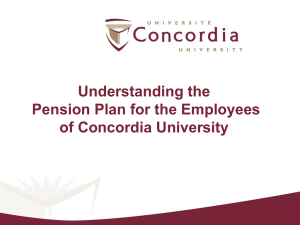China`s Endowment Insurance - East
advertisement

China’s Endowment Insurance Lu Jianren Chinese Academy of Social Sciences September 29, 2011, Washington, D.C. 1 Main Contents • I. Three Development Stages of China’s Endowment Insurance System • II. Framework of Urban Enterprise Endowment Insurance System • III. Challenges • IV. New Progress and Development Direction 2 I. Three Development Stages of China’s Endowment Insurance • Since the founding of the People’s Republic of China, the China’s endowment insurance has experienced three development stages: • 1. Labor insurance (1950s) • 2. Social insurance (1978-1998) • 3 Balance pension insurance in both urban and rural areas (now days) 3 Stage1: Labor insurance • In 1951, the Chinese central government specified the treatment of retirees of stateowned enterprises. • In 1955, the State Council of China issued the regulations on the treatment of retirees of government authorities and public service units. 4 Stage1:Labor insurance • In rural areas, special groups including those who are unable to work, who have no source of livelihood, who are aged people, and who are handicapped are all supported by the government. As for the large group of farmers, the sources of livelihood in their old age are that from their children or other family members and their land. 5 Stage1: Labor insurance • During the Cultural Revolutionary (19691978), the social coordination endowment insurance system for enterprise employees was suspended. 6 Stage2: Social insurance • After implementing the reform and opening-up policy in 1978, China began to reestablish its endowment insurance system for enterprise employees. Since 1998, China has newly established a basic pension insurance system and developed relevant supporting framework. During the period, 4 major achievements have been gained in the pension insurance system for enterprise employees in urban areas: 7 Four major achievements • (1) From “enterprise insurance” to social insurance: Since 1984, enterprise employees’ pension has been coordinated with social assistances. Thanks to social mutual assistances, enterprises neither have to shoulder extremely heavy burdens on premier pension, nor enjoy almost no burden at all. 8 Four major achievements • (2) Pension that was solely borne by enterprise has turned to that coshouldered by the country, the enterprise and the individual: Currently, in China, the employee, the employing entity and government subsidy jointly contribute to the pension fund. The employing entity shall pay 20% of its payroll as pension premium. The employee shall pay 8% of his/her wage for the same purpose. 9 Four major achievements • The revenue of basic pension insurance fund of the country has increased from RMB 145.9 billion in 1998 to RMB 1219.5 billion in 2010. Employing entities and employees, who pay 80% of the insurance premium, are the major players of the system, and government subsidy acts only as a supplement. The social security fund, as a part of strategic national stockpile, received total revenue of RMB 1707.1 billion in 2010. 10 Four major achievements • (3) Timely and full funding of basic pension for enterprise retirees has been ensured: Since 1998, retirees have begun to withdraw their pension premium at banks, post offices or other social service agencies instead of from their employing entities, ensuring timely and full funding of basic pension for about 63 million retired cadres and workers. 11 Four major achievements • Since 2004, we have eliminated current pension default. Currently, over 70% of enterprise retirees have been listed as service objects of the community management entities, which have reduced the burden of enterprises on social affairs. 12 Four major achievements • (4) New methods of the calculation and issue of pension premium have been introduced: In the past, the retiree’s pension was 65%-75% of his/her wage before retirement. Now, the basic pension of the retirees is calculated based on a proportionate number (1% for 1 full year) of the local average wage and his/her average contribution wage, reflecting the principle of equality of rights and obligations. 13 Fund increasing slowly • The number of urban basic endowment insurance participants has increased from 110 million in 1998 to 275 million in 2010, with a monthly pension of RMB 413 to RMB 1300(Yuan). By 2010, cumulative enterprise annuity fund (as supplementary pension) has reached RMB 300 billion. The slowly increasing fund has benefited about 11.76 million employees, only accounting for 15% of the country’s total 78.4 million employees. 14 Stage3: Balance pension insurance in both urban and rural areas • Currently, China’s pension system is about to enter a new historical stage that both urban and rural residents shall have access to pension insurance in line with a series of normative rules and regulations. By 2020, China will have basically established a pension system that covers both urban and rural residents, to ultimately ensure the full coverage of pension system up and down the country. 15 II. Framework of Urban Enterprise Endowment Insurance System • 1. Basic Endowment Insurance System • 2. Enterprise annuity fund (supplementary pension) • 3. Personal deposit insurance 16 Basic Endowment Insurance System • In China, the basic pension insurance fund is made up of payment from the employing entities, individuals and government subsidies. Basic pension insurance involves both social coordination (or social pooling) and personal accounts. • (1) Basic operation mode: social coordination + personal account. Social coordination: PAYG (pay as you go) Personal account: 8% of individual’s contribution wage (wholly paid by individuals, and it is accumulative) 17 Basic Endowment Insurance System • (2) Beneficiaries: various enterprises and their employees, public service units and their staff members, sole proprietors (or self-employers) and flexible employees in urban areas. 18 Basic Endowment Insurance System • (3) Fund raising: enterprises and employees contribute to a large portion of the pension fund, among which, the part paid by the enterprise is no more than 20% of its payroll, and that by the employee is 8%. The central government also grants subsidy to the middle and western part of the country every year. Besides, the national social security fund has been set up as a part of strategic stockpile. 19 Basic Endowment Insurance System • (4) Basic pension premium • The basic pension is made up of the coordinated pension and the pension in the personal account. • The basic pension is determined based on factors such as the individual's cumulative premium payment period, the wage from which premium payment is made, the average wage of the local workers, the amount in the personal account and the average life expectancy of the urban population. 20 Basic Endowment Insurance System • (5) Eligible pension obtainer • (a) The individual reaches the statutory retirement age, i.e. male employee, 60; female official, 55; female worker, 50. • (b) Cumulative premium payment period should reach 15 years. • Should one is at the age of retirement, but his/her cumulative premium payment period doesn’t reach 15 years, he/she is unable to obtain the social basic pension. Deposit amount of personal accounts is paid in a lump sum, and his/her pension relationship is terminated. 21 Basic Endowment Insurance System • (6) Treatment adjustment: The basic pension standard of enterprise retirees will be adjusted based on the average wage of the employees and the change of commodity prices. 22 Enterprise annuity fund (supplementary pension) • Enterprises and employees are voluntary to participate in the supplementary pension system. • (1) Basic operation mode: The pension fund is paid by both the enterprise and the employee who participate in the supplementary system. Individual’s pension payments are all accumulated to the personal account, which is managed by the market and supervised by the government. 23 Enterprise annuity fund (supplementary pension) • (2) Fund sources: Enterprise payment cannot exceed one twelfth of its payroll of last year; employee’s payment cannot exceed one twelfth of his/her total wage of last year; the part of enterprise payment which is within 4% of the payroll can be listed as production cost. 24 Personal deposit insurance • Currently, some places have issued personal deposit insurance, but there is no national unified policy in this regard. 25 III. Challenges • 1. Aging of the population • 2. Incomplete system 26 Aging of the population • China has become an aging society since 1999. By 2010, there have been 177 million people at the age of 60 and over, accounting for 13.26% of the total. The aging group is increased sharply with a rapid growth rate. China has entered an aging society before it grows to a developed country. The dependency ratio of endowment insurance is soared because a large number of people retire earlier. In 1990s, the dependency ratio was 5:1, and now the figure turns to 3:1, bringing severe challenges for the pension payment. 27 Incomplete system • (1) Since the pension systems of employing entities (inclusive of enterprises and authority/public service units) are not synchronized, it is difficult for employees who change their jobs between the enterprise and authority/public service units to maintain their original pension insurance relationship. The gap between the pension of enterprise retirees and that of authority/public service unit retirees is increased continuously. 28 Incomplete system • (2) Pension systems in urban and rural areas are not matched. The current enterprise endowment insurance system is designed for urban employees, while the pension rights and interests of rural migrant workers whose income is unstable and low and who change jobs frequently can not be effectively guaranteed. 29 Incomplete system • (c) A Part of urban residents are excluded from the pension security system. The overall endowment insurance system is still incomplete. 30 IV. New progress and development direction • 1. Major progress of the building of endowment insurance system • 2. Development direction 31 Major progress of the building of endowment insurance system • (1)In 2009, a pilot project for new rural social endowment insurance program was initiated up and down the country, which is combined with individual payment, collective payment and government subsidy. By 2011, the program has covered 400 million rural residents, marking that China’s pension system has made its first step to benefit the broad rural areas. 32 Major progress of the building of endowment insurance system • (2)The Social Insurance Law of China was released in 2010, which stipulates that the state establishes and improves the social pension insurance system for urban residents. This Law took into effect on July 1, 2011, which is a big event for the Chinese people’s political, economic and social life. 33 Major progress of the building of endowment insurance system • (3)The central government of China decides to initiate the pilot project for urban pension insurance program this year, which is combined with social mutual assistances and personal account, and is associated with family supporting, social relief, aid and welfare, to guarantee the basic livelihood of aged urban residents. The pilot project was initiated on July 1, 2011, benefiting 60% of the aged urban residents at the first step. By 2012, the program will have covered almost all the aged urban residents. 34 Development direction • (1) Distinguish the social coordination account (or social pooling account) and personal account. To address the challenges brought by the coming of aging population peak, and to institutionalize the operation mode of pension system, we will better distinguish the social coordination account and the personal account in a wider range, and preserve or increase the amount of personal account, so as to ensure the sustainable development of endowment insurance system. 35 Development direction • (2) Ensure that the pension system can benefit more people. Workers of non state-owned enterprises, sole proprietors (or self employers) and other workers in flexible employment are and will be considered as major participants of the pension system in the near future, so as to ensure that more citizens can be benefited from the system. We will actively find out the solutions to the difficulties of rural migrant workers in participating in the pension programs, work out how to guarantee the basic living standards of the unemployed aged residents in urban areas, and advance the pension reform in pubic service units. 36 Development direction • (3)To promote more pension programs to increase the premiums of aged people. Firstly, we shall improve the basic pension system that involves both social coordination and personal accounts. Secondly, we will encourage enterprises to establish annuity fund in line with their performance, to enhance the living standards of their retirees. Thirdly, we will continuously standardize the issuance market, stimulate the development of commercial insurance, and encourage workers to participate in personal deposit insurance. 37 Thanks! 38




